Asphalt
Asphalt pavement for a garage is not the most common solution, because to implement it, it is not enough to just go to a hardware store. But there is nothing complicated in high-quality asphalt finishing, you just need to solve a couple of simple questions:
- Purchase the asphalt crumb itself (calculation of about 2-2.2 tons for a garage of 9 m2).
- Rent a vibrating plate (about 500-1000 rubles per day, depending on the region). You can get by with a hand roller, but with a vibrating plate, leveling the surface will be easier and faster.
You can lay asphalt on the floor of the garage in just one day. All you need to do is spread the crumbs around the perimeter, level them with a rule (a mop-type tool – a handle with a board on the end), moisten them and compact them with a vibrating plate.
With a little effort, you will get a coating with undeniable advantages:
- Provides high-quality traction for wheels.
- Impervious to temperature changes.
- Resistant to chemicals, gasoline, oil.
- Allows seamless installation.
- Lasts 8-10 years, after which minor repairs may be required.
Important! Asphalt is good for garages without an inspection pit or cellar. If the floor is uneven, you will have to assemble the formwork around the opening or choose another flooring option.
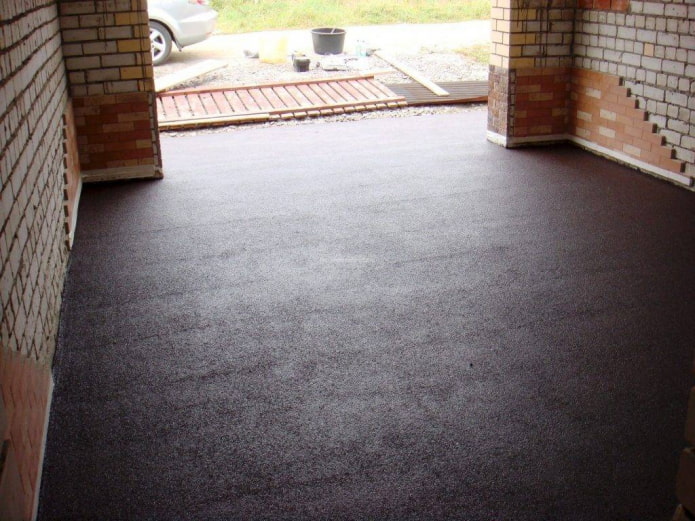
Concrete
It is not without reason that the classic concrete floor has become the “favorite” of most garage owners. Advantages of concrete screed:
- Budget-friendly. The cost of material for pouring 1 square meter (excluding work) will cost an average of 300-500 rubles – taking into account pouring a 5 cm layer (50 kg of dry mix).
- Resistant. To aggressive chemical influences, moisture, temperature fluctuations, mechanical loads.
- Eco-friendly. Cement, sand and water are usually all the components that make up a screed mix.
- Easy to pour. You can make a concrete floor yourself.
Unfortunately, this option is not without its drawbacks:
- High probability of dirt and dust formation during operation.
- Need to use equipment to simplify and speed up pouring.
- For independent work you will need at least a mixer, but in addition to it it is also advisable to use a compressor and a trowel.
The correct sequence of actions includes many stages in addition to mixing and laying the concrete itself:
- Remove 20-30 centimeters of soil.
- Fill in 10-15 cm of gravel or crushed stone.
- Fill in a 10-centimeter cushion of sand, tamp.
- Lay down a waterproofing material (it is advisable to pour a thin layer of screed under it, 15-20 mm thick).
- Pour the finishing coat (5-7 cm), taking into account the expansion gaps along the walls and reinforcing with rebar.
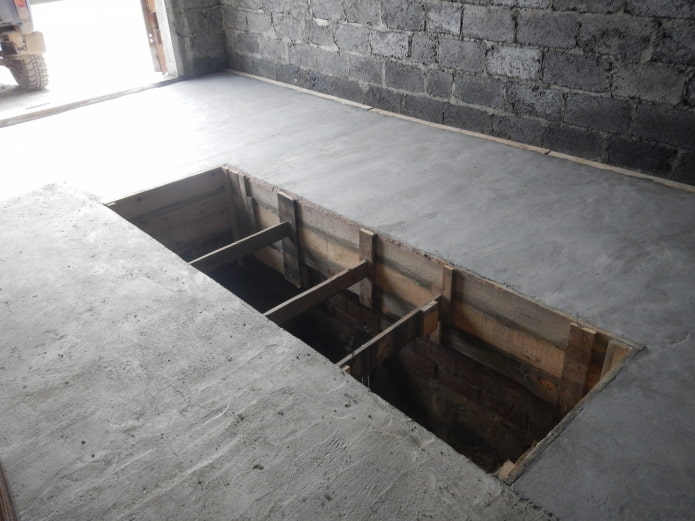
Wood
Wooden floors are laid anywhere – in houses, baths, barns. But this material is rarely used as a floor in a garage, because it has a number of disadvantages:
- It deeply absorbs any flammable and lubricating materials – the remaining stains do not interfere with operation, but spoil the appearance.
- Wood is poorly resistant to constant contact with car tires, as a result of which abrasions form on the floor.
- Constant high humidity (a common occurrence in garage boxes) also reduces the service life of the boards due to fungal damage.
- When installing wood, low fire safety should be taken into account – the material easily ignites and spreads flames perfectly.
To increase the resistance of natural wood to loads, fire, water, etc., the floor should be regularly (about once a year) treated over the entire area with special impregnations or paints. Those who agree to provide such care in the future will receive as a result:
- The ability to make a garage floor on your own. All you need is floorboards, joist beams, a saw or jigsaw, nails with a hammer or screws with a screwdriver.
- An environmentally friendly coating at a low price. A 6-meter board, 50 mm thick and 150 mm wide will cost about 500 rubles. A pleasant smell as a gift!
- It is possible to repair or replace damaged planks.
- Warm floors and a comfortable atmosphere without additional costs.
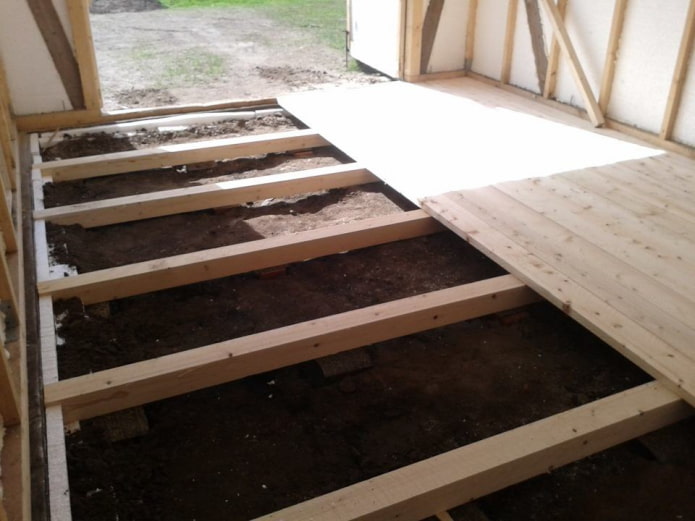
Earth
An earthen garage floor is not really a floor at all — it is simply compacted soil protected from grass growth by a film (it also provides waterproofing). All that is needed for implementation is to remove the top layer of soil (~20 cm), lay polyethylene or geotextile, return the soil to its place, tamping it every 5 centimeters of the embankment.
Important! Because of the compaction of the excavated soil, there will not be enough soil, you will have to buy more. The average cost is 500-700 rubles per cubic meter.
Since the earthen floor is the most budget option, it does not have too many advantages:
- Cheap. All you need is earth, a shovel, rammer, film.
- Simple. Experience in construction and finishing works is not required.
- Fast. It can be laid in just a few hours.
There are many more disadvantages of an earthen floor in a garage:
- Dirty. The earth is a source of dust (and if water gets inside, then dirt too), settling on the car body, shoes, things, furniture.
- Cold. The earthen floor in the garage is one of the coldest, it will be cool inside even in the heat.
- Short-lived. Even if the soil is laid correctly, it will be compressed, and after a short time it will need to be filled up.
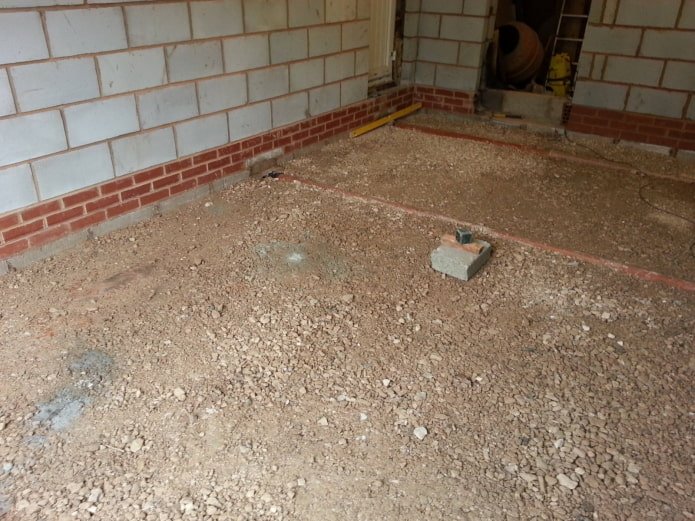
Porcelain tiles
Durable ceramic tiles can be called an option for elite garage boxes: in terms of quality, porcelain tiles are ideal for garage conditions, but they are not cheap – so if the budget is limited, it is worth taking a closer look at other flooring options.
Advantages of porcelain tiles for the floor:
- Durability. The service life is at least 15-20 years, but with proper installation, the tiles will last all 50.
- Durability. Porcelain tiles can withstand temperature changes, high humidity, exposure to chemicals, falling heavy objects – for example, tools or car parts.
- Environmentally friendly. Floor tiles are made from a mixture of clay, sand, feldspar and pigments, by heating and pressing. They are considered 100% natural material.
- Aesthetics. The cost of expensive material is paid off by its appropriate appearance.
- Possibility of insulation. If the garage is used not only as a parking lot, a heated floor system can be installed under the porcelain tiles.
- Easy to maintain. You can wash it either by hand or with a high-pressure washer.
The most noticeable disadvantages, apart from the high cost:
- It can only be laid on a flat surface (cement screed).
- It does not conduct heat well (it is cold in itself).
- The slabs, although reliable in operation, are quite fragile during transportation.
- The presence of seams that require additional care.
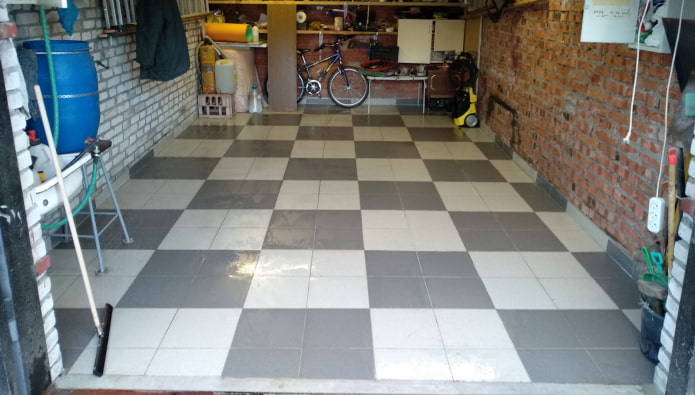
Ceramic tiles
A more budget-friendly option for granite tiles is small-format thin ceramic tiles. It is cheaper, and its quality is almost equal to that of its “big brother”:
- Eco-friendly. It is essentially fired clay with a glaze coating.
- Moisture-resistant. It does not absorb water and is not damaged by chemical compounds.
- Wear-resistant. Neither the weight of the car nor constant driving on the tiles will spoil its appearance.
- Frost- and heat-resistant. It lies quietly in unheated rooms in winter.
- Easy to maintain. It can be washed with a hose with or without pressurized water.
- Diverse. Thanks to a wide range of colors and textures, everyone will find a suitable option for their garage. In addition, tiles can be combined to create an unusual pattern or achieve the desired effect.
Ceramic tiles have only 2 relative disadvantages:
- Less durable compared to porcelain stoneware. The tile is stronger than, for example, wood, but due to its small thickness it is inferior in this property to porcelain stoneware. If a heavy hammer falls, it will most likely crack. But there is good news – to fix the situation, it is enough to replace only one element.
- The need to prepare the floor. The surface must be level, it is best to lay it on a screed, which requires additional financial and time investments.
- The presence of seams, which are the “Achilles heel” of the tiled floor.
Important! Glossy glazed tiles will slide when in contact with water – choose a matte, rough surface. The latter is less beautiful, but more practical.
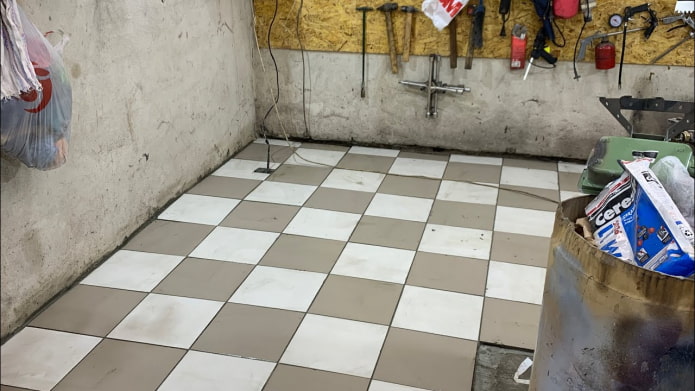
Self-leveling floor
Self-leveling polymer floor combines the advantages of seamless screed and durable porcelain stoneware. This type of garage floor is one of the most expensive, but the high price is justified by a number of undeniable advantages:
- Long service life, measured in decades.
- No seams, making the maintenance process easier.
- Non-absorbent surface, allowing you not to worry about spilled water or gasoline.
- Temperature resistance, which allows you to pour the polymer both in an unheated room and on top of a heated floor.
In general, self-leveling floors are not afraid of water, chemicals, mechanical impacts, heat and frost. More detailed characteristics depend on the type of polymer:
- Polyurethane composition. It is not afraid of anything, but a special advantage is its resistance to impacts. An ideal option for a garage or workshop, the only drawback is the high cost.
- Methyl methacrylate. Its properties are not inferior to polyurethane, but it has an unpleasant odor that lasts until it dries completely.
- Epoxy. Overall, a good option, but can be damaged by a heavy object falling on it.
- Cement-acrylic. Due to its budget composition, it can crack over time.
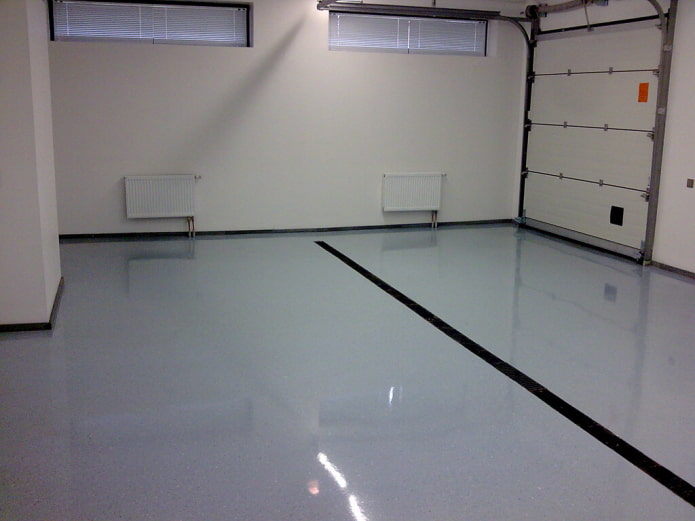
Metal
The floor in the garage can also be metal. Metal is famous for its strength, durability, and resistance to loads. Corrugated steel panels or relief slabs are suitable as floor coverings.
The grating is attached to the supporting strips using special fasteners. The metal tiles are connected to each other like a puzzle, laid on a special glue, resulting in a strong, uniform covering.
Let’s start with the disadvantages, there are few of them: firstly, the material is expensive. Secondly, it is not easy to cut the metal to size, you will need a special tool. But having solved these problems, you will get a garage floor with a lot of advantages:
- Resistance to constant loads and impacts.
- Good adhesion to the surface, thanks to the grid or texture.
- Easy to keep clean (garbage falls into the cells or is easily swept off the smooth slabs).
- Unlimited service life – a metal floor is made “for centuries”.
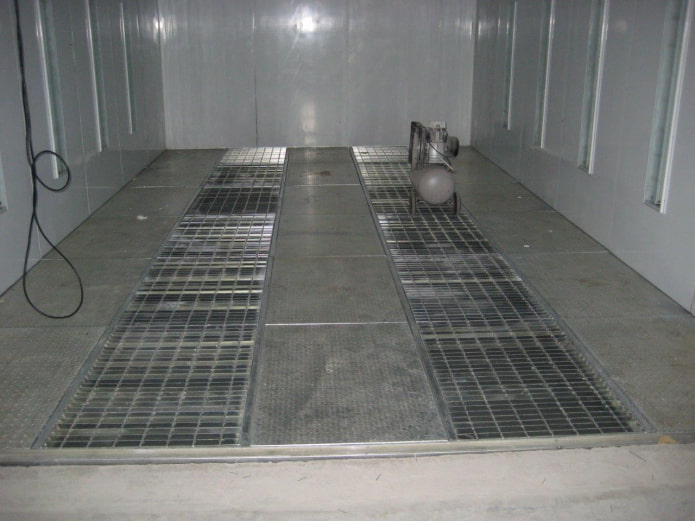
Rubber
Rubber is one of the most underestimated materials in finishing. With an average cost of raw materials and high speed of work, you can get a floor that:
- Is not afraid of accidental impacts and falling heavy objects.
- Has excellent soundproofing properties.
- Does not slip even when wet – comfortable to ride and walk.
- Steady withstands temperature changes – heat and frost.
- Does not deteriorate from moisture.
- Easy to clean.
The only nuance that you should be careful with is fire. If there is a potbelly stove in the garage or the barbecue is regularly taken out, it is better to abandon rubber on the floor in favor of concrete, ceramics, metal.
A variety of coating options are produced from rubber crumb: from small tiles or rolls to a liquid self-leveling composition. For a garage, the easiest way is to use rolled rubber – you can buy it according to the width of the garage and cover the perimeter in one piece without seams. However, you will have to spend money on transportation.
The second method is tiles, which are essentially similar to children’s rugs or puzzles – the pieces cling to each other using the tongue and groove principle and hold in place perfectly. The advantage of tiles is their convenient transportation and ease of repair – if necessary, a damaged part can be replaced with a new one without re-laying the floor.

Paving slabs
When porcelain stoneware is expensive and ceramic tiles are unreliable, paving slabs appear on the scene. Another underrated material that meets all the requirements of garage finishing:
- Durable. Perfectly withstands the weight of moving or static transport.
- Resistant to fire, water, high and low temperatures.
- Easy to lay (lays directly on dry sand, no need to mix glue or mortar).
- Aesthetic. Large selection of shapes, sizes, shades. Can be combined with each other, laying out patterns.
Laying is not much different from ordinary asphalt, only paving stones do not require special equipment. It is enough to remove the soil, make a dense base of gravel and sand, pour a mixture of sand and cement on top, deepen the tiles, fill the seams with the same mixture.
The only controversial issue is the price – too cheap may be of poor quality, expensive will cost a pretty penny and eat up most of the budget. Choose trusted suppliers who work in the middle price category.
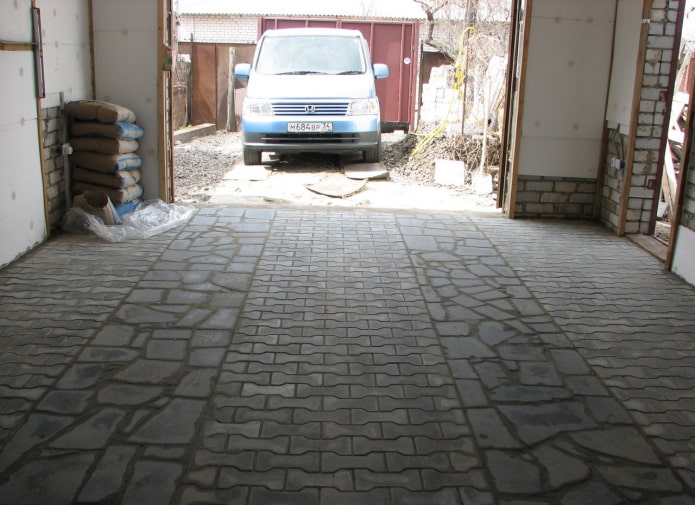
Finally, advice – in order not to miscalculate with the floor covering and calculate all possible costs in advance, consider not only the price of the material itself, but also the preparation of the surface: concrete screed, glue, sand and gravel also cost money.
Now reading:
- 10 Ready-Made Color Combinations to Create a Cozy Living Room
- How to clean your washing machine: steps to remove dirt, scale and odor.
- How to choose the best window sill for an apartment: types, colors and design (35 photos)
- Choosing a gate for a country house: types, sizes and design solutions (40 photos)
- Children’s room design ideas 10 sq. m: TOP-50 photos for inspiration